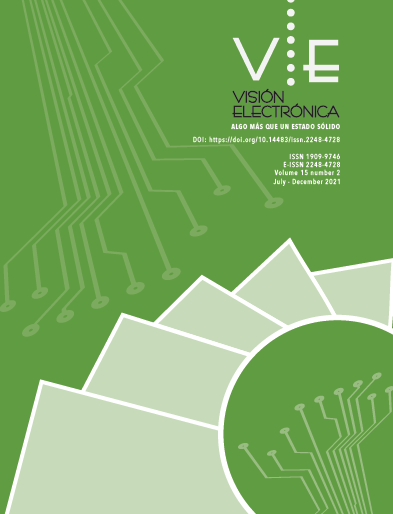Publicado:
2023-03-13Número:
Vol. 17 Núm. 1 (2023)Sección:
Visión ActualPsychophysiological Analysis of Sound Stimuli
Análisis Psicofisiológico de Estímulos Sonoros
Palabras clave:
EEG, Neurosky, IADS, Digital Signal Processing, DREAMER (en).Palabras clave:
EEG, NeuroSky, IADS, Procesamiento Digital de Señales, DREAMER (es).Descargas
Resumen (en)
Electroencephalography signals (EEG) has captured the general interest of the scientific community; nowadays, the most part of the investigations of the topic are focused on the emotional psychophysiological effect that this kind of signals are able to show according different types of stimuli; therefore, this document shows the analysis of different sets of EEG signals, captured by NeuroSky headset, under the stimulation produced by emotional content sounds from the IADS (International Affective Digital Sounds); furthermore, some EEG signals from the "DREAMER" dataset were also analyzed. From this document was mainly concluded that there was a corresponsive result between subjective and objective data as valence and arousal values were corresponsive with EEG frequency bands; furthermore, for DREAMER set, electrodes of the right hemisphere were the ones with more energy.
Resumen (es)
Las señales de electroencefalografía (EEG) han captado el interés de la comunidad científica; actualmente, la mayoría de las investigaciones están enfocadas a cómo estas señales reflejan la respuesta psicofisiológica de las personas, en términos emocionales, respecto a diferentes estímulos; por esta razón, en este documento se presenta el análisis de señales de EEG captadas por el headset de NeuroSky ante estímulos sonoros con contenido emocional provenientes de la IADS (International Affective Digital Sounds); además, se analizaron algunas señales del dataset de EEG “DREAMER”. De este desarrollo se llegó a que hay una correspondencia entre los valores de Valencia y Arousal con las bandas de frecuencia de EEG, observando además que, para el caso del DREAMER, los electrodos correspondientes al hemisferio derecho presentaban la mayoría de la energía en el cerebro.
Referencias
N. S. Suhaimi, J. Mountstephens, and J. Teo, "EEG-Based Emotion Recognition: A State-of-the-Art Review of Current Trends and Opportunities," Computational Intelligence and Neuroscience, vol. 2020. https://doi.org/10.1155/2020/8875426
Y. Li, J. Cai, Q. Dong, L. Wu, and Q. Chen, "Psychophysiological responses of young people to soundscapes in actual rural and city environments," AES: Journal of the Audio Engineering Society, vol. 68, no. 12, pp. 910-925, 2020. https://doi.org/10.17743/jaes.2020.0060
R. Subramanian et al., "ASCERTAIN: Emotion and personality recognition using commercial sensors," IEEE Transactions on Affective Computing, vol. 9, no. 2, pp. 147-160, 2018. https://doi.org/10.1109/TAFFC.2016.2625250
S. Katsigiannis and N. Ramzan, "DREAMER: A Database for Emotion Recognition Through EEG and ECG Signals from Wireless Low-cost Off-the-Shelf Devices," IEEE Journal of Biomedical and Health Informatics, vol. 22, no. 1, pp. 98-107, 2018. https://doi.org/10.1109/JBHI.2017.2688239
R. Sarno, M. N. Munawar, and B. T. Nugraha, "Real-time electroencephalography-based emotion recognition system," International Review on Computers and Software, vol. 11, no. 5, pp. 456-465, 2016. https://doi.org/10.15866/irecos.v11i5.9334
J. de Zor, "Informe 'Las Frecuencias Cerebrales o la puerta del espacio'," [Online]. Available: https://www.hispamap.net/ondas.html
NeuroSky, "EEG: The Ultimate Guide," [Online]. Available: http://neurosky.com/biosensors/eeg-sensor/ultimate-guide-to-eeg/
M. X. Cohen, "Analyzing Neural Time Series Data: Theory and Practice," J. Grafman, Ed. Cambridge, MA; London, England: The MIT Press, 2014. https://doi.org/10.7551/mitpress/9609.001.0001
Z. Lan et al., "Real-time EEG-based emotion monitoring using stable features," Visual Computer, vol. 32, no. 3, pp. 347-358, 2016. https://doi.org/10.1007/s00371-015-1183-y
"bandpower - MATLAB & Simulink - MathWorks," [Online]. Available: https://www.mathworks.com/help/signal/ref/bandpower.html
J. Kim, W. Kim, and J.-T. Kim, "Psycho-physiological responses of drivers to road section types and elapsed driving time on a freeway," Can. J. Civ. Eng., vol. 42, pp. 881-888, 2015. https://doi.org/10.1139/cjce-2014-0392
Notes of "Second Order Filters" from Electroacoustic Transducers; class notes for 9843-03B - 0150 - 4534; Faculty of Engineering, Sound Engineering, Universidad de San Buenaventura, Academic Semester 2021-1.
B. Pueo and M. Romá, "Electroacústica, Altavoces y Micrófonos," Pearson Educación, S.A., Madrid, Spain.
Notes of "Microphones" from Electroacoustics; class notes for 7973-03B - 0333 - 7252; Faculty of Engineering, Sound Engineering, Universidad de San Buenaventura, Academic Semester 2020-2.
Jfetronic: Electrónica y Más (2017): "El mejor preamplificador para micrófono Electret. muy Fácil," [Online]. Available: https://m.youtube.com/watch?v=W6rgCptYbLQ&ab_channel=Jfetronic%3AElectrónicayMás
L. A. Luengas-C. and D. C. Toloza, "Análisis frecuencial y de la densidad espectral de potencia de la estabilidad de sujetos amputados," Tecnológicas, vol. 23, no. 48, pp. 1-16, 2020. https://doi.org/10.22430/22565337.1453
Cómo citar
APA
ACM
ACS
ABNT
Chicago
Harvard
IEEE
MLA
Turabian
Vancouver
Descargar cita
Visitas
Descargas
Licencia

Esta obra está bajo una licencia internacional Creative Commons Atribución-NoComercial 4.0.
.png)
atribución- no comercial 4.0 International






.jpg)





